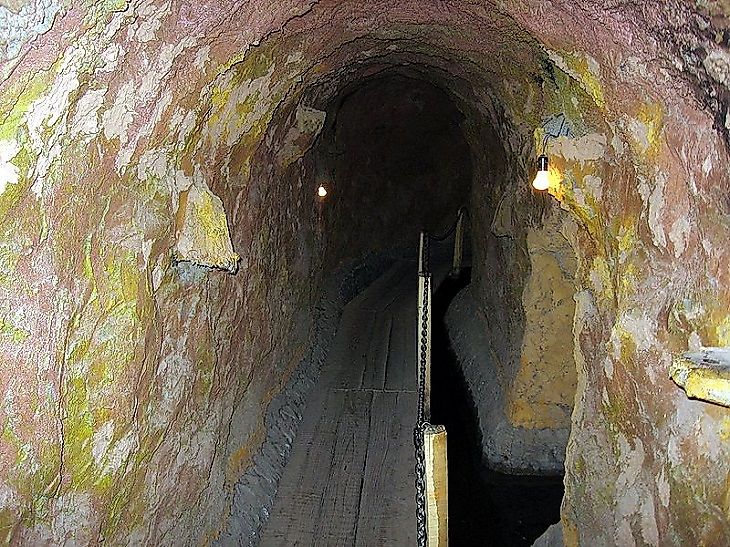What Is A Qanat, And Where Are They Found?

Ancient Aquifer Construction
A Qanat (sometimes referred to as karez in Turkish, or kārīz or kārēz) is translated as meaning "channel". Qanats are underground structures used to collect groundwater and stream them to the surface. Qanats have traditionally been most common in the mountainous regions of Central Asia and the Caucasus. Water from Qanats were used for water supply and irrigation. A Qanat consists of one or more drainage galleries of 1 to 1.4 meters high and widths of 0.5 to 0.6 meters, with fortified walls paved within the aquifer. The vertical ventilation wells, which also served to allow access by qanat builders and repairmen, were connected with drainage galleries leading to the drainage channel. The lengths of Qanat galleries could reach up to several kilometers. In the late 17th and early 18th Centuries, the French and British explorer Jean Chardin wrote that Iranians were not only able to accurately locate the water at the foot of the hills, but also to move the water at distances up to 60 kilometers, and sometimes more.
The First Underground "Pipes"
At the beginning of the First Millennium BC, the small tribal groups gradually began to move onto the Iranian Plateau where there was less rain falling in comparison to the areas from where they had come from. The tribes were accustomed to the land cultivation skills made possible with the presence of an abundance of rivers and streams, so they had to search for access to groundwater. On the territory of the Iranian Plateau, dry seasons were more regular and severe, and, in general, most of the annual rainfall, meager as it was, was generated during the period from October to April. Ancient farmers tried to dig channels in areas of seasonal appearances of water, but in summer channels dried up. Ancient farmers in the region had noticed that the flow of water that had accumulated in the miners' tunnels had not dried up. Farmers made a deal with the miners who were looking for copper, tasking them with the construction of several tunnels. They wanted to see if the water taken from different places and put in one stream would be enough for irrigation. The ancient Iranian farmers used the water, which distracted miners from getting copper, and thus established the basic system of underground conduits of water for irrigating their agricultural lands in these hot, dry climates. According to archaeological excavations, the innovation took place in the northwest of what is now Iran, near the border with present-day Turkey.
A Skillful Craft
The Qanat building craft used to be handed down from father to son, and required a detailed understanding of subsurface geology and engineering. One of the most important conditions for creating a Qanat was the observance of a Qanat's gradient (angle) in its drainage galleries. Too small of an angle would not allow a current to flow, and too steep of an angle would lead to excessive erosion and destruction of underground conduits. On average, one meter of properly constructed drainage galleries gives 0.3 to 0.6 liters of water per second.
There was a book written by Persian and Iraqi mathematician and engineer Karaji in 1010 which narrated the story of groundwater engineering. In this book, titled "Extraction of Hidden Waters", the technical details of the construction and repair of these Qanats were laid out, as well as methods for the detection of underground water galleries and calculations of slope levels. Around this same period, the number and impact of Qanats was so significant that the authorities in the region had introduced legal regulations concerning them. Although the ancient Iranians were considered to be the unsurpassed builders of Qanats, knowledge of the movement of groundwater quickly spread from there into Central Asia and the Southern Caucasus (Armenia, Azerbaijan, and then into the Arabian Peninsula (Saudi, Oman, and the United Arab Emirates and even North Africa (Egypt, Tunisia, Morocco. The construction of qanats came to be seen as far away as China.
Way Too Old!
British researchers believe that the construction of underground water lines dates back to two different periods. True qanats were first constructed in Persia, and then the Romans built a kind of similar water systems after being influenced by Middle Eastern innovations during their rule in Egypt (from 30 BC to AD 395).
The remains of irrigation systems in the area of construction of reservoir dams of Seymareh, found in 2014, according to estimates of Iranian archaeologists, date back to the Fourth Millennium BC. If confirmed, it will give an answer to the question as to when the qanat technology originated. If these dates at Seymareh are proven, it will shoe that the earliest qanats came to be not at the beginning of the 1st Millennium BC, but instead by as early as 2,000 years before then!











